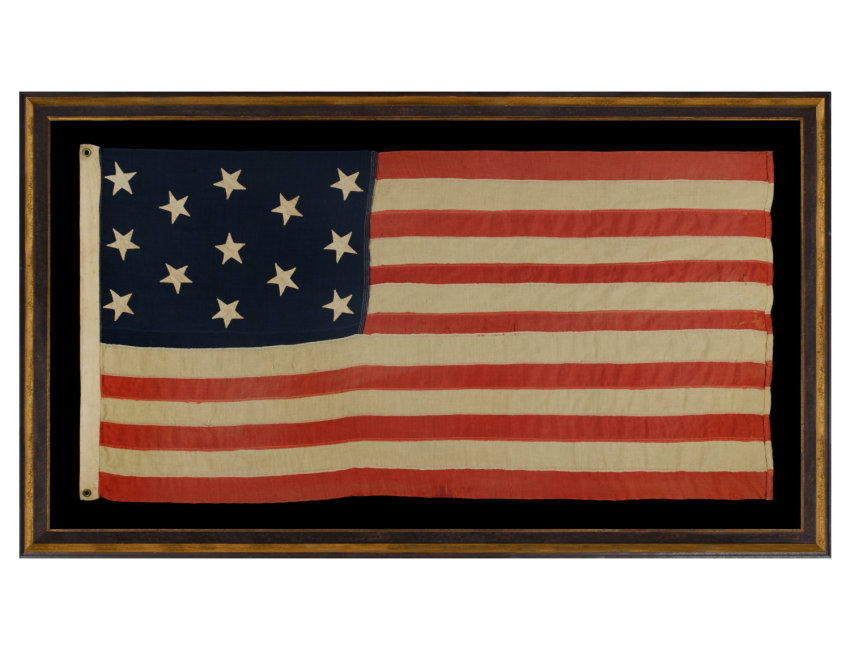|

|
Description: |
|
| 13 star American national flag of the type flown by the U.S. Navy in the 1870-1880's period. Because the Navy's flags of this era were made in the same fashion as many of those produced in cottage industry settings for private use, it can be difficult to ascertain the intended purpose of a 13 star flag made in this period with 100% certainty. Some, for example, were produced to glorify the original 13 colonies during the 1876 centennial of American independence. But the size and proportions of this particular example suggest it was the most common of the Navy's small boat ensigns, as they were termed, which varied between 2.9 feet x 5.5 feet and 3.2 x 6 feet. These small flags were flown at the stern, from a gaff, or from the yard-arm on a larger vessel, or as the primary flag on a skiff or other small craft that carried sailors back and forth to shore.
The Navy usually produced their own flags. Because these objects were hand-made there was a good deal of irregularity and variation. Crude features and interesting star placement abound in known examples. Note how the stars on this example vary in position on their vertical axis.
The U.S. Navy used the 13 star count on small national flags, not only in the 18th century, but throughout much or all of the 19th century, particularly the second half. Ship captains were paranoid about the ability of foreign ships to recognize the flag on the open seas. On small flags in particular, viewed through a spyglass at a distance, the ability discern individual stars was of great concern. Keeping the count at 13 maintained better visibility and consistency. The practice theoretically ended in 1916 following an executive order from then-President Woodrow Wilson, though old military traditions die hard and according to at least one expert, Wilson�s order did not completely dispel the presence of 13 star flags on U.S. Navy craft.
The stars of this example are arranged in rows of 3-2-3-2-3, which is the most often seen pattern in 13 star flags following the Civil War. In most cases the design can also be viewed as a diamond of stars with a star in each corner, or as a combination of the crosses of St. Andrew and St. George, which some experts feel was the design of the very first American flag and serves as a link between this star pattern and the British Union Jack.
The flag's relatively small size when compared to others made during the 19th century adds considerable appeal. In modern times, this flag might be considered large by the casual observer. Prior to the 1890�s, however, it is extremely small when compared to its counterparts with sewn construction. Printed parade flags (sometimes called hand-wavers) were generally three feet long or smaller, but flags with sewn construction were generally eight feet long and larger. This is because flags needed to be seen from a distance to be effective in their purpose as signals, while today their use is more often decorative and the general display of patriotism. In the 19th century, even those flags made for decorative purpose were often large by today�s standards, so the average 19th century sewn flag can be cumbersome to frame and display in an indoor setting. This is why many collectors prefer printed parade flags and smaller sewn flags, like this one.
13 star flags have been used throughout our Nation�s history for a variety of purposes. Some private ships flew 13 star flags during the same period as the Navy, and the use of yachting ensigns with a wreath of 13 stars surrounding an anchor, which began in 1848, still persists today. Among other uses, 13 star flags were carried by soldiers during the Mexican and Civil Wars and displayed at various patriotic events, including Lafayette�s final visit to the U.S. in 1825-26, the celebration of the Nation's centennial of independence in 1876, and the sesquicentennial in 1926.
Construction: The stars are made of cotton, hand-sewn and double-appliqu�d, which means that they are applied to both sides of the blue canton. The stripes and stars are made of wool bunting, joined by treadle-stitching. There is a twill cotton header with two brass grommets for hoisting. Note how the canton is pieced with two lengths of blue wool bunting. The widest wool bunting was eighteen inches, so larger cantons required piecework. In this case the task was undertaken by hand-stitching.
Mounting: The flag has been hand-stitched to 100% natural fabrics on every seam and throughout the star field. fabric of similar coloration was chosen for masking purposes. The flag was then hand-stitched to a background of 100% cotton, black in color, which was washed to remove excess dye. An acid-free agent was added to the wash to further set the dye, and the fabric was heat-treated for the same purpose. The mount was then placed in a black-painted, hand-gilded and distressed Italian molding. The glazing is U.V. protective acrylic. |
| Inventory Number: |
|
|
|
Dealer |
Jeff R. Bridgman American Antiques, llc |
| Contact |
Jeff Bridgman |
Phone: (717) 502-1281 |
|
| Period: |
19th Century (1801-1900) |
|
| Date: |
1876 |
|
| Origin: |
|
|
| Condition: |
See Item Description |
|
| Measurements: |
Frame: 45" x 78.75" Flag: 35.25" x 67.75" |
|
| Inventory |
Other Inventory by this Dealer |
|
| Web-site: |
http://www.jeffbridgman.com |
|
| Price: |
SOLD |
|
| E-mail: |
Inquire
|
|
Click thumbnail
to view larger
|
